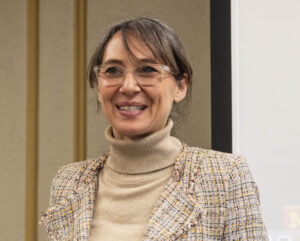
Launching my career in a disrupted media landscape, I became skilled in multimedia news. As a senior digital editor, I helped journalists learn how to embrace technological advances, to tell stories in new ways to audiences who expect news delivered to their ever-changing hand-held devices.
But another disruption shaped my career and life, one wrought by climate change and increasingly extreme weather. When Hurricane María devastated Puerto Rico in 2017, eventually causing more than 2,900 deaths and nearly $100 billion in damages, it left many newsrooms, mine included, in shambles. What good is all the technology in the world when the power grid and internet are knocked offline for up to six months?
What do you do when whole regions of your audience are entirely cut off from communications and desperately need information to save their lives?
We were forced to adapt and get information to those in need. We improvised and launched successful text-based versions of our websites, making the news easier for
audiences with limited internet to download.
Later, I realized that few newsrooms have comprehensive editorial and operational plans for natural disasters—especially small and medium-sized newsrooms already working with scarce resources because of the financial challenges facing journalism. So, I applied to the Knight-Wallace Fellowship to address this problem and to create guidelines for newsrooms affected by the devastating natural disasters they must cover.
Could journalists use ham radios to get our stories to the public when we lose our beloved internet?
After diving into the 24,000 courses offered at the University of Michigan, I began auditing a course called “Extreme Weather in a Changing Climate.” Professor Perry Samson helped me understand the recipe for hurricanes and how to better forecast which areas will be affected by storm surges in order to plan where to deploy reporting teams. He introduced me to the five wind tunnels at the university. I became particularly fascinated with one used to simulate tropical storms. I also discovered dozens of online resources to help me and the journalists I would marshal better cover the next natural disaster.
I learned about nuclear winter and geomagnetic storms, a “sneeze” from the sun that can destroy all communications across the planet for months. Each class was simultaneously mind-blowing and amazingly straightforward. I cringed each time Prof. Samson pointed out simple mistakes committed by newsrooms, such as journalists using the wrong hurricane symbol.
I was eager to share what I was learning with others. Working with Wallace House, I convened “Covering Natural Disasters: A Newsroom Preparedness Symposium.” We invited a group of select reporters and editors from Michigan, Texas, California, and Florida to come to Ann Arbor and join my class of Knight-Wallace Fellows for a day of collaborative learning with extreme weather experts. The symposium ended with us breaking into small groups and workshopping best practices for bringing together operational and editorial processes. I am now turning these ideas into a set of guidelines for newsrooms.
Among my biggest fascinations from the year was a paper I found about the historical role of radio amateurs in helping devastated communities during natural disasters. I learned that Herbert V. Akerberg, a student in Michigan, gave birth to emergency radio after a disastrous flood in Ohio in 1913.
That story of a young radio amateur whose mother brought him meals so he could continue broadcasting during the night stuck in my mind. Could journalists use ham radios to get our stories to the public when we lose our beloved internet?
The answer is yes, we can. Although several amateur radio programs exist, I could not find any that actively partnered with newsrooms. In March, I became certified as a spotter for the Skywarn program to report to the National Weather Service and city emergency offices about extreme weather conditions.
Satellites, as it turns out, can’t see everything. If a family has difficulty getting out of a house in the middle of a flood, there is no way for a satellite to know. Nor can a satellite identify when a tornado knocks down a line of 10 or 20 trees. But people in communities connected by radio can get the word out.
I knew immediately that the fellowship had opened a new door for me: to become an amateur radio journalist. I won’t be the first. I met a fellow amateur radio journalist living in Michigan. After I finish writing my emergency guidelines, my next step as an experienced digital leader will be to ensure that multiplatform news outlets understand the analog skills they still need to survive.
María Arce is Editorial Coach for Latin America at Global Press, where she leads learning and professional development for a team of reporters in the region. She also accepted a Reynold’s Journalism Institute Fellowship where she will continue her Knight-Wallace Fellowship work and develop and launch a training and resource guide on how journalists can work
with ham radio operators.
This article appeared in the Spring 2023 issue of the Wallace House Journal
